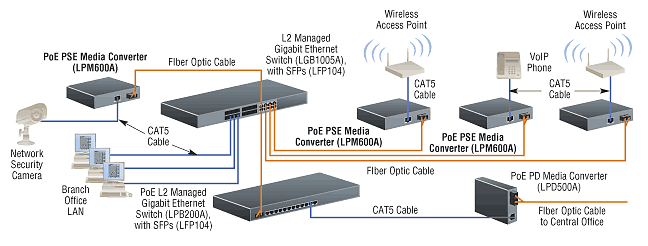There are three different types of Power over Ethernet (PoE) standards: IEEE 802.3af, IEEE 802.3at, and High Power over Ethernet (HPoE).
IEEE 802.3af is the most common type of PoE, and is sometimes referred to as “PoE” or “PoE+”. It is the original PoE standard, released in 2003. It can deliver up to 15.4 watts of power per port.
IEEE 802.3at is an updated version of the 802.3af standard, released in 2009. It can deliver up to 30 watts of power per port.
High Power over Ethernet (HPoE) is a newer standard that was developed by the Ethernet Alliance and released in 2016. It can deliver up to 60 watts of power per port. HPoE is not compatible with older versions of PoE equipment, so it is important to make sure that all devices in your network support HPoE before investing in this technology.
Why Use PoE?
PoE (Power over Ethernet) is a technology that allows network devices to be powered through the Ethernet cable. This means that you only need one cable to provide both power and data to the device, which can simplify your network setup and reduce clutter.
PoE is also useful for devices that are located in difficult-to-reach places, as you don’t need to worry about running separate power cables to them. And because the power is delivered through the Ethernet cable, there is no risk of electrical shock.
Finally, PoE can be a more cost-effective solution than traditional AC power, as it eliminates the need for extra equipment like AC adapters and transformers.
How Does PoE Work?
PoE standards define how much power can be delivered over Ethernet cabling, and there are three main standards that are in use today: 802.3af, 802.3at and 802.3bt.
802.3af is the original PoE standard, released in 2003. It can provide up to 15.4 watts of power per port, which is enough to power most small devices like phones and access points.
802.3at was released in 2009 and increased the maximum power per port to 30 watts. This is enough to power larger devices like IP cameras and some VoIP phones.
802.3bt was released in 2018 and increased the maximum power per port to 90 watts. This is enough to power high-end devices like 4K TVs and gaming consoles.
To ensure that your devices are compatible with the PoE standard that you’re using, look for the “IEEE 802.3af” or “IEEE 802..3at” logo on the device or its packaging.
What are the Benefits of PoE?
Power over Ethernet, or PoE, is a technology that allows networked devices to receive power through the same Ethernet cable that carries data. This can be useful in a variety of situations, from simplifying installations to providing power to devices in locations where there is no convenient AC outlet.
There are two main benefits of using PoE: convenience and cost-effectiveness.
PoE is convenient because it eliminates the need to install separate power cables for networking devices. This can make installation and maintenance simpler and less expensive. In some cases, PoE can also allow devices to be powered remotely, which can be helpful in difficult-to-access locations.
PoE is also cost-effective because it uses existing Ethernet infrastructure to deliver power. This means that there is no need to install dedicated power lines or equipment. Additionally, PoE can often be deployed using existing wiring, which can further reduce costs.
Applications of PoE
As the world of networking technology continues to evolve, so too do the applications for Power over Ethernet (PoE). While initially designed as a way to deliver power to devices over standard Ethernet cabling, PoE has since been adapted for a wide range of uses.
Some of the most common applications for PoE include:
-IP Phones: IP phones can be powered using PoE, eliminating the need for a separate power cable. This simplifies installation and reduces clutter.
-Wireless Access Points: Wireless access points can also be powered using PoE, making it easier to deploy and manage wireless networks.
-CCTV Cameras: Security cameras can be powered using PoE, which helps to simplify installation and reduce costs.
-Point-of-Sale Terminals: PoE can be used to power point-of-sale terminals, eliminating the need for a dedicated power outlet. This makes it ideal for retail environments.


